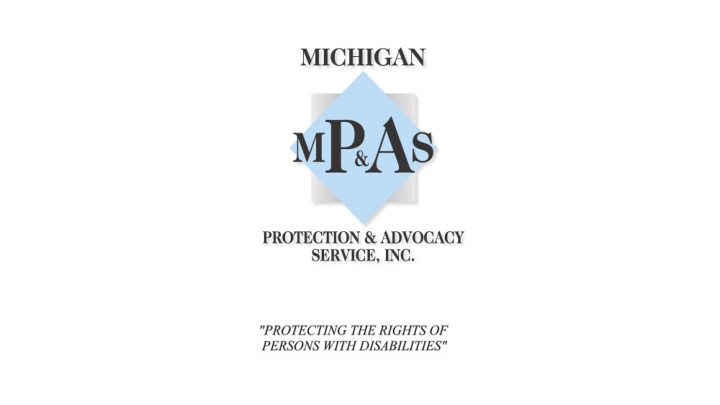



Transition: One Student, Many Systems By: Liz Shawl June 16, 2020
What was your first job? How did you get it?
What is Transition?
• 1. Student-centered services or activities aimed at increasing community inclusion and post-high school success. • 2.The goal is for the student to be prepared to thrive in the community with a skill set and possible employment.
What Matters Most in Transition? • Pillars of Transition: Self Advocacy, Employment, Education/Training, Independent Living and Community Involvement Student Focused Planning Agency Collaboration Early Planning Supported Decision Making Program Structure Family Engagement
It All Starts With IDEA • 20 U.S.C. § 1400 et seq.; 34 C.F.R. § 300 et seq. • Transition 34 CFR § 300.34: • Coordinated activities • Results-oriented • Academic and functional • Facilitating movement from school to post-school activities • Postsecondary, voc-ed, integrated employment, adult ed, independent living, community participation • Instruction; related services; community experiences
Part of the IEP • Begin at age 16 or earlier • Update annually • Appropriate and measurable postsecondary goals • Age appropriate transition assessments to inform the goals • Training, Education, Employment, Independent Living Skills • Child must be invited to attend • Must ensure that child’s preferences are considered.
Student Involvement: During an IEP • Special Education Techer -50% • Coordinating agencies and programs- 20% • Student- 10% (which is up from a general IEP which is 0%) • Administration- 8% • Family -8% • General Education- 4%
**Coordinate with Other Agencies** • District must invite public agency rep responsible for paying for services or providing services • Must get consent each time District invites • District is responsible for ensuring that all parts of IEP are implemented • Even if other agency drops the ball
Vocational Rehabilitation Services • Importance of Workforce Innovation and Opportunity Act (WIOA) • VR Agency in each state and territory; some states have a separate agency serving those with blindness. • VR must work with the Lead Educational Agency (LEA) to provide transition services. • 34 C.F.R § 361.48
VR and Transition Requirements • Students must meet the age requirement • Must have a disability under Section 504 or the Rehabilitation Act • Must use 15% of funds and any other funds • 34 C.F.R. § 361.65. • Applying for VR Services is not a requirement for Pre- Employment Transition Services (Pre- ETS)
What Can VR Do? • School Outreach • Provide IEP Team input • Assess impact of Disability on employment • Career counseling • Assistance in preparing for, finding, and maintaining employment
Pre-ETS • Job exploration • Workplace readiness • Counseling • 34 C.F.R. § 361.48.
Developmental Disability Services (DD) • Services and structure varies due to Medicaid state plans and waivers • Use of a Person-Centered Planning (PCP) approach • Home and Community Based Services (HCBS) • Community Living Supports (CLS) • Supported Employment • Medicaid Waivers
Transition Services • Coordinated set of activities • Academic and Functional to facilitate the movement from school to post-school • Postsecondary education, vocational education, integrated employment, continuing education, adult services, independent living, community participation • Includes needs, strengths, preferences and interests
Client Story #1
What Would You Do?
Strategy: • Functional Behavior Assessment (FBA) • Independent Educational Evaluation (IEE). • Pre-ETS from VR
Outcome: • Evaluations showed the student needed more employment skills • A meeting was held to collaborate with all the providers involved • Negotiated with the local district and ISD — Based on the recommendations a program was developed
Takeaway • Evaluations • National Technical Assistance on Transition Toolkit • DCDT/CEC/National Secondary Transition Technical Assistance Center (NSTTAC)/Zarrow Center • Team effort – a cross system approach can benefit the student in many settings. • Behavior and communication needs can impact transition • Needs being met
Cli lient Story ry #2
What Would You Do?
Strategy: • Negotiate with school to allow student to continue to attend school • File a state complaint
Outcome: • The school developed a new program • Met needs of more students • Resolved some of the limitations with Project Search • The school partnered with VR • VR was a funding resource through Pre-ETS services • The school connected with more community partners • created innovative job sites for the students
Takeaway: • In Michigan, special education goes from birth to age 26,which is why the school district was still involved here. • Michigan Administrative Rules for Special Education (MARSE) R. 340.1702 • Be creative, use alternatives; • Look at the whole community; • Consider community, college, Vocational Technical Program, or a neighboring school district.
Cli lient Story ry #3
What Would You Do?
Strategy: • Personal Curriculum (PC) • Audit of students credits • Requested Transition Evaluations
Outcome: • Team came together to create a plan that met the students needs • Worked with vocational trades/skill center • Used PC to meet the requirements for graduation
Takeaway: • Student led • Informed choice • Realistic/Real world • Additional tools • LRE • 504/ADA communication • Dig deeper • Further Advocacy • Examples of systemic change
Systemic Advocacy: • Look at your state and see what is being done at the state level and get involved! • Employment First Initiative • NTACT Capacity Building grants • Look at what other states are doing and how can you bring that home. • When you get involved, see who is not at the table and try to include them.
Additional Resources: • Transition Coalition: https://transitioncoalition.org/ • National Technical Assistance Center on Transition: https://transitionta.org/toolkit-resources • DCDT: https://community.cec.sped.org/dcdt/home • Center for Exceptional Children: https://www.cec.sped.org/ • Zarrow Center: http://www.ou.edu/education/centers-and- partnerships/zarrow • Kohler Taxonomy for Transition: https://transitionuniverse.files.wordpress.com/2012/04/taxonomy.pd f
Resources Continued: • Indicator 13 Checklist: https://transitionta.org/sites/default/files/transitionplanning/NSTTAC _ChecklistFormA.pdf • WINTAC: http://www.wintac.org/topic-areas/pre-employment- transition-services • Y-TAC: https://y-tac.org/ • AHEAD: https://www.ahead.org/home • Workforce GPS: https://www.workforcegps.org/ • Indiana Secondary Transition Resource Center: https://instrc.indiana.edu/transition-resources/transition-matrix.html • Project E3: Educate, Empower, Employ: https://projecte3.com/
Questions?
Liz Shawl Michigan Protection and Advocacy Service eshawl@mpas.org
Recommend
More recommend